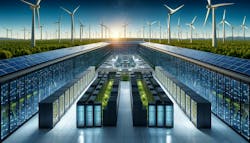Energizing the Future: How AI Innovations Power Sustainable Data Centers
Artificial Intelligence is advancing so quickly today that it's easy to forget the iterative progress that has spanned the 75 years since Alan Turing first asked, "Can machines think?" 1956 saw the first AI conference; DARPA funded its first AI research at MIT in 1963. Moore's Law, which articulated how rapidly computers would gain the power and storage needed to simulate human thought, was published in 1965, Carnegie Mellon developed the first self-driving car in 1986, and 1997 saw the IBM Deep Blue computer defeat chess master Gary Kasparov as well as the release of the first speech recognition software from Dragon Systems. It's also interesting to note that no computer could defeat a master of the strategy board game Go until 2016.
Today, hardly a day goes by without a new headline announcing a step forward for AI, even if the headlines aren't always clear about their social, scientific, or business benefits.
However, one crucial area where AI makes a difference is delivering electricity powered by clean energy. Grids can take several different approaches to increasing the amount of clean or green energy consumed by their customers, and this is an especially important topic when it comes to powering the latest generation of data centers.
In this article, we are limiting our discussion to the approach known as 24/7 Carbon-Free Energy (CFE). CFE is a process where, for this discussion, a data center provider contracts with a grid provider to ensure that a pre-determined percentage of electrical power will be locally generated, renewable, and/or carbon-free. This agreement is measured in time increments of, in some cases, each hour so the success metrics can be evaluated in near real-time rather than waiting until the end of the week or month.
How does AI play a role in 24/7 CFE?
Identifying, bidding on, and purchasing energy from green power sources requires tremendous real-time data and machine processing. Machines and software make decisions based on rules and criteria defined to react to dynamic conditions across the power grid and market.
Time-based Environmental Attribute Certificates ("T-EACs") demonstrate that an MWh of carbon-free electricity delivered was produced in the same hour of the day. This process differs from Renewable Energy Certificates (RECs), which effectively transfer accounting for clean energy from other sources and locations without ensuring the power used at a location is either renewable or carbon-free.
In a pilot project jointly established between EdgeConneX data centers and Gridmatic, in conjunction with the ERCOT power grid in Texas and initiated in early 2023, the results have been successful by almost any metric. The project delivered carbon-free and renewable power that exceeded all original goals, rising from 39% CFE before the pilot to an annual average of 86% CFE in its first year.
For comparison, at any given time on a given day, ERCOT's mix of carbon-free and renewable energy may reach 50% of its total output, but this varies as solar, wind, or hydropower availability changes under different conditions. Averaged annually, ERCOT's mix of green electrical power was 40% in 2023. These comparisons illustrate the importance of negotiating terms, SLAs, and pricing with a grid provider when initiating a 24/7 CFE project.
Using AI to help access, acquire, and measure clean energy is just a start. In the future, AI will play an essential role in optimizing data center design, operations, layout, capacity, sustainability, and DCIM services. But 24/7 CFE offers tremendous promise, serving as a catalyst for more clean energy on power grids in markets around the world and helping data centers achieve the goals of many in the industry who are committed to being carbon-neutral in the coming decade.
It may not generate the publicity that accompanied Deep Blue's chess victory, but it shows that AI is already helping to accomplish critical business goals without quite as much fanfare.
Data Center providers don't create AI models, Cloud services, or Streaming Content services. But we enable, empower, and accelerate those and virtually every other primary industry worldwide. In the future, we know that AI service providers will be important customers in data centers around the world, and early adoption with practical applications can lead to successes that teach us a lot about what AI can do to help those same data centers to function more efficiently, effectively, and sustainably.
About the Author

Phillip Marangella
Phillip Marangella is Chief Marketing and Product Officer for EdgeConneX. EdgeConneX, is a global data center provider focused on driving innovation. Contact EdgeConneX to learn more about their 100% customer-defined data center and infrastructure solutions.



